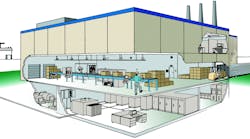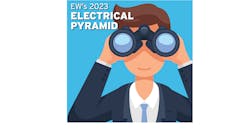Let's take a quick multiple-choice quiz on the state of co-op funds in the electrical wholesaling industry. Which of the following choices is true?
a) Co-op funds can be an indispensable resource that distributors can use to fuel promotional and marketing activities that create demand for vendors' products.
b) Co-op funds are under-utilized.
c) Manufacturers see co-op funds as a necessary evil.
d) The use and abuse of co-op funds is starting to attract attention from legal authorities.
e) All of the above.
Surprisingly, the answer is “all of the above,” and that's what makes co-op funds one of the most confusing conundrums in the electrical wholesaling industry. The concept of co-op advertising, where a vendor gives a distributor funds to be used for specific promotional or marketing activities intended to create demand for that vendor's products, isn't new. In fact, co-op funds were used more than 100 years ago in the retail business and have been popular in the electrical market for decades.
But with their use has come abuse. Hank Bergson, president, National Electrical Manufacturers Representatives Association (NEMRA), Tarrytown, N.Y., sees the value in the use of co-op funds to create product demand. In his many years in the electrical business, he has seen plenty of abuse, too.
“It has to drive product off the distributors' shelves to a satisfied end-user customers,” Bergson says. “It all depends on how the electrical distributor perceives his co-op advertising dollars. Does the distributor perceive that as another profit center, and that it doesn't have to be spent on co-op?
“Distributors have come to expect the co-op dollars. If it's dealt with like that, it's the same as rebates and all that other stuff. The manufacturer is forced to make a distinction if there is value received for the deployment of that resource, or if it's a price concession. At least half the co-op dollars are being spent as they are intended, and the other half are being diverted from their original purpose. If you add that up in this industry, it's a lot of money. When we waste money, it makes us inefficient.”
David Gordon, one of the principals for Channel Marketing Group (CMG), Pittsburgh, has worked with co-op programs and market development funds (MDFs) for most of his electrical career, which included posts as a marketing executive for IMARK Group, Oxon Hill, Md., and SourceAlliance.com. He says co-op funding really breaks down into two components:
-
The traditional co-op funding arrangement as an accrual process, where a vendors' distributor gets a set percentage of co-op dollars for purchasing specific amounts of product.
-
Market development funds (MDFs), where a distributor submits a marketing plan to a manufacturer that outlines strategies to create demand for that manufacturers' products.
Says Gordon, “The better distributors are taking MDF dollars — and sometimes MDF and co-op — and are presenting a plan to the manufacturer. The manufacturer will then decide to fund that. That's more flat-rate dollars. It can be flat-rate with a percent of sales, and sometimes vendors tie into incentive- or frequency-programs that go to customers. The manufacturer may pay for some of the award components.”
Big dollars are available through co-op programs and MDFs. According to an article Gordon wrote in the March 2003 issue of Progressive Distributor magazine, a $20 million distributor should have access to a minimum of $72,000 in co-op funding.
He says manufacturers historically only pay out 30 percent to 60 percent of their co-op accruals because many distributors neither collect their funds nor conduct marketing activities.
Indeed, the co-op funding that some electrical distributors have enjoyed is now the stuff of legend in the electrical marketing community. Several years ago, one large electrical distributor in the Northeast reportedly got $300,000 in co-op funds. Several sources contacted for this article agree the amount of co-op dollars is on the decline, and that MDFs have become more important.
Linda Schalles runs her own marketing and public relations firm, LMS Marketing Resources, Wayne, Pa. When she worked for her family's business, Colonial Electric Supply, King of Prussia, Pa., she managed the company's co-op program and would ask each vendor what type of co-op money was available, work with the company's management team to develop plans to maximize those co-op dollars, and track how much co-op dollars the company got annually on a vendor-by-vendor basis. She says in the 1990s, co-op funds were flowing into the company, but that by 2000, the money was becoming harder to find.
“It just seemed like the money was drying up, that the advertising co-op dollars were becoming less available,” she says. “I've heard that from other people in the advertising industry, not just in the electrical business.”
John Lyle, vice president of operations, Griffith Electric Supply Co. Inc., Trenton N.J., says funds are not as easy to get. “Manufacturers tell us less funds are available, or say, ‘Tell us what your activity is and I will see if I can get it pre-approved. Before they would just say, ‘You have a thousand dollars to spend.’”
Part of this trend is due to the increasing importance of MDFs, says Gordon of CMG. “There are a number of manufacturers who have been pulling back on their stated co-op programs because they realize their top two tiers of distributors — the chains and the stronger independents — are going to them with MDF plans,” he says. “The manufacturers fund those to whatever appropriate level they desire. It's usually a negotiated thing.”
Rob Hand, president and CEO, Hand Promotion Inc., Austin, Texas, has worked with co-op funds and MDFs for more than 30 years in many retail and wholesale industries. He tracks the mix of co-op funds versus MDF funding, and says that while MDFs account for 58 percent of funding for respondents to his HPM 2003 Trade Promotion Survey, co-op accrual funds have increased a few percentage points in recent years.
In a 2003 edition of his Monday Morning Memo e-mail newsletter, Hand said that in the 1990s, “The paradigm shifted away from fixed accrual-based (co-op) programs fund budgets to more discretionary fund types (MDF). But now the data suggests a modest gain back to accrual-based programs.”
BACK TO BASICS
Despite the move toward MDFs and more strategic use of marketing funds, there's no question that electrical distributors and their customers still love the basic trinkets and counter days available through co-op funding. These activities are often funded with the traditional 50/50 distributor-manufacturer split, as long as the activities meet the manufacturers' specifications for co-op funding.
Says Warren Baum, vice president of purchasing, Griffith Electric Supply, “I come from the old school and believe in the old-fashioned way. We use most of our co-op dollars for T-shirts and sweatshirts. We use our coop money to promote our name.
“I come from a family of electricians, and they all fight for T-shirts. My brother is the chief electrician at the Philadelphia Zoo. Electricians frequently come into our counter wearing other distributors' T-shirts. We can't allow that, so we have a program here where we give them two shirts for one if they will take the competitor's T-shirt off their back.”
One of Baum's co-workers says customers still love the proverbial free lunch. “Two years ago, we started something in the summer called ‘Dog Days of Summer,’” says John Liles. “We bought a hot-dog cart and had a manufacturer come in every Wednesday and sponsor a day. Out of their co-op money, they would pay for the sodas and hot dogs. If customers bought ‘X’ amount of dollars, they would get T-shirts. If they didn't buy enough, they would still get a free lunch. That's working out very well.”
Today's co-op programs are fairly similar in structure to those of previous years, says Miriam Blazowski, national accounts marketing manager, EGS/Appleton and O-Z/Gedney, Rosemont, Ill. “Distributors are requesting funding for the same old types of activities: golf outings, counter days, trade shows, logo merchandise,” she says. “More creative distributors are asking for ‘technology funding’ — having a manufacturer pay for the cost of a branch personal computer or handheld device. These requests have declined, as they are out of the scope of marketing activities. However, more distributors are using funds specifically for reaching the end customer — training and a product specialist are two of the most common uses of this.”
Counter days partially sponsored by co-op funds remain popular. Capital Light & Supply/Sonepar, Alexandria, Va., often runs at least 20 counter days a month at its 19 branches throughout the Washington, D.C.-Baltimore metropolitan area, Virginia and Maryland. John Hardy, the company's president, has seen his vendors offer more than just the basic promotional items, and he and his management team work closely to customize joint-events such as trips to NASCAR events, fishing trips and golf outings. “Vendors used to just say, ‘Here are our T-shirts and here are our cups and hats,’” he says. “Now they are coming forward with programs that say, ‘Here are the basic tools. We will modify them for you.’ Vendors have always had their prepackaged promotions, but some now have terrific ideas and tools that we can use.”
“Frequent flyer” or “points” programs are now popular, where distributors' customers earn points based on purchases that they can cash in for vendor products, logo apparel from distributors, ‘tickets’ to distributor outings, or merchandise from national retailers.
One example of a distributor “frequent flyer” program is “Club Extralite” at www.clubextralite.com. In this program, Western Extralite Co., Kansas City, Mo., offers customers more than 1,500 awards, including business equipment, sporting goods, electronics, points that can be redeemed for training, and the opportunity to donate the points to a local charity in the name of their company. Western Extralite has more than 40 electrical manufacturers participating in the program.
While these frequent-flyer programs seem to be growing in popularity, one marketing executive who asked not to be named, said monitoring these programs can be a huge hassle to administer, particularly if a distributor's computer system isn't up to the task.
MORE AND MORE MDFS
If an electrical distributor isn't already developing MDFs with their key vendors, they should probably start doing so now. The flow of funds seems to be running toward MDFs in the electrical business. But it's also just smart marketing, plain and simple. Planning a marketing campaign to create demand for products ultimately enhances the mutual profitability of a distributor and vendor.
Despite budget squeezes for marketing dollars, manufacturers very often can find the funds for good MDFs, says David Gordon of CMG. “The way they can do some of the MDF (funding) is that they will have a number of distributors who will not use any or most of their co-op dollars,” he says.
“The distributor can go to the manufacturer with a plan. Most manufacturers don't admit to this, but they can move dollars around within a territory. Every manufacturer should want a distributor who is really a marketing leader in the marketplace. He should almost overfund that guy, because he is going to create local brand awareness. There are manufacturer benefits beyond just that distributor.”
Another ally in the search for funding for co-op and MDFs is the local independent manufacturers rep. NEMRA's Hank Bergson says some local reps have become the “custodian” of these marketing funds and can make co-op dollars available for approved marketing activities.
THE FUTURE OF FUNDING
No one contacted for this article expects co-op or MDF funding to dry up completely because these marketing tools are proven methods of creating product demand in local markets (when used for their intended purposes). But marketing executives see a storm on the horizon in the form of the Sarbanes-Oxley Act that goes into effect in November.
Section 404 of that law requires public companies to scrutinize and audit their internal accounting like never before. Sloppy accounting of promotional allowances, vendor rebates and co-op funding are already attracting the interest of the Securities and Exchange Commission (SEC), even before Sarbanes-Oxley goes into effect.
Two cases in the food service industry should be of interest. Dutch grocery giant Ahold NV recently settled a case with the SEC over charges that Ahold “fraudulently inflated promotional allowances” at its U.S. Foodservice subsidiary, a large food distributor in the United States. A recent The New York Times report said U.S. Foodservice was accused of overstating its earning in at least fiscal 2001 and 2002 by more than $800 million by booking revenue from promotional rebates from suppliers that had never been earned. In another case, grocery wholesaler Fleming Companies Inc., Lewisville, Texas, allegedly overstated earnings in late 2001 and first-half 2002 by reporting fictitious transactions with suppliers to inflate its income. Fleming also allegedly bought excess inventory at the end of fiscal quarters to earn trade promotion cash rebates and volume discounts that improved the appearances of its finances.
Rob Hand, of Hand Promotion Inc., has been tracking Sarbanes-Oxley compliance as it applies to co-op funds and MDFs closely, and believes that manufacturers, distributors and reps cannot take this new law lightly. He believes private companies may one day soon have to disclose their accounting in these areas, too. For more information on the topic, check out his Web site at www.handpromotion.com.
All this new SEC interest into the accounting for promotional allowances shouldn't overshadow the potential of co-op funding and MDFs when distributors and their vendor partners play by the rules and use these resources for their intended purposes.
Says one industry marketing executive, “It's the way most distributors fund their marketing activities. Distributors are working on such tight margins that they can't afford to spend ‘X’ percent to promote the manufacturer business. If we go back 15 to 20 years ago, manufacturers used to do a lot more marketing. They cut that and moved it onto distribution. So there has got to be a revenue share.”
PLAN FOR THE MARKETING BLITZ
Many distributors, manufacturers and industry observers will agree these marketing dollars are tougher to come by than in years past, but electrical distributors with a well-constructed plan to find co-op and MDF funds will reap the rewards. Here are some key points to consider as you develop your plan of attack.
Develop a database of manufacturers that offer co-op or MDF funds. Make sure the database outlines all co-op opportunities your vendors offer and includes marketing contacts who have approval over these funds at manufacturers' headquarters.
Don't confuse co-op activities with strategic marketing plans. Your marketing plan should direct the implementation of the tactics — such as co-op funded promotions and giveaways. The activities should not drive the plans. These promotions and giveaways should add up to be your marketing plan. David Gordon of Channel Marketing Group recommends that classic co-op expenditures on items like hats, shirts, golf balls and signage shouldn't exceed 25 percent of marketing budget.
Plan your marketing calendar six months to a year in advance. Try to break it down by market segment.
Include manufacturers and reps in the process. Ask manufacturers and their local reps or field salespeople what funds are available. Include reps and manufacturers in your planning process as you develop your annual marketing strategy and marketing events calendar.
Track the co-op dollars you earn and the success of the programs they fund. Your manufacturers need to know if the co-op dollars they are spending with you are returning on the investment.
Play by the rules. Your vendors aren't naïve. They are ready for — and probably expect — their distributors to attempt to use co-op funds for activities for which they weren't intended. With the Sarbanes-Oxley law requiring tighter accounting audits, your manufacturers will be asking for more documentation of any marketing activities you fund with their co-op or MDF dollars.
TOOLS OF THE TRADE
Many of the basic co-op activities haven't changed much over the years. Check with each vendor on requirements for the use of its logos and signage for any co-op funded items or activities. Many vendors don't fund activities unless it has a direct tie-in to their company or product lines. The days of vendors funding any and all distributor promotions, trade shows and counter days that don't offer any specific vendor promotion are probably numbered. Here are the basics:
- Hats, T-shirts, key chains, and the other basic promotional items
- On-hold vendor messages
- “Frequent flyer” or points programs
- Print ads
- Radio spots
- Television commercials
- Mailers
- Counter days
- Trade shows
- Open houses
- Sales spiffs
- Catalogs
- Literature
- Ad reprints
- Company newsletters








